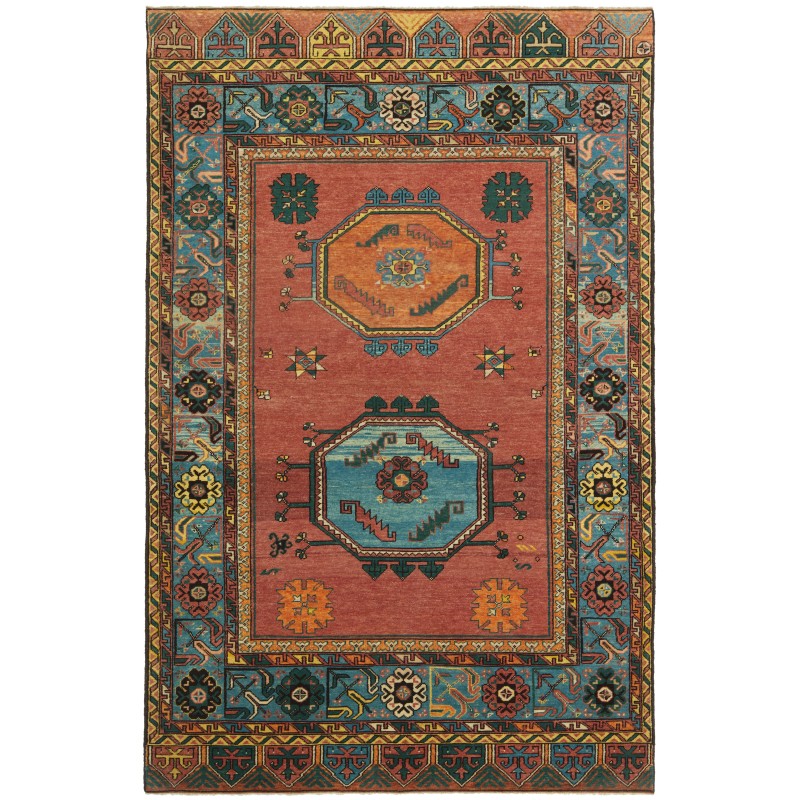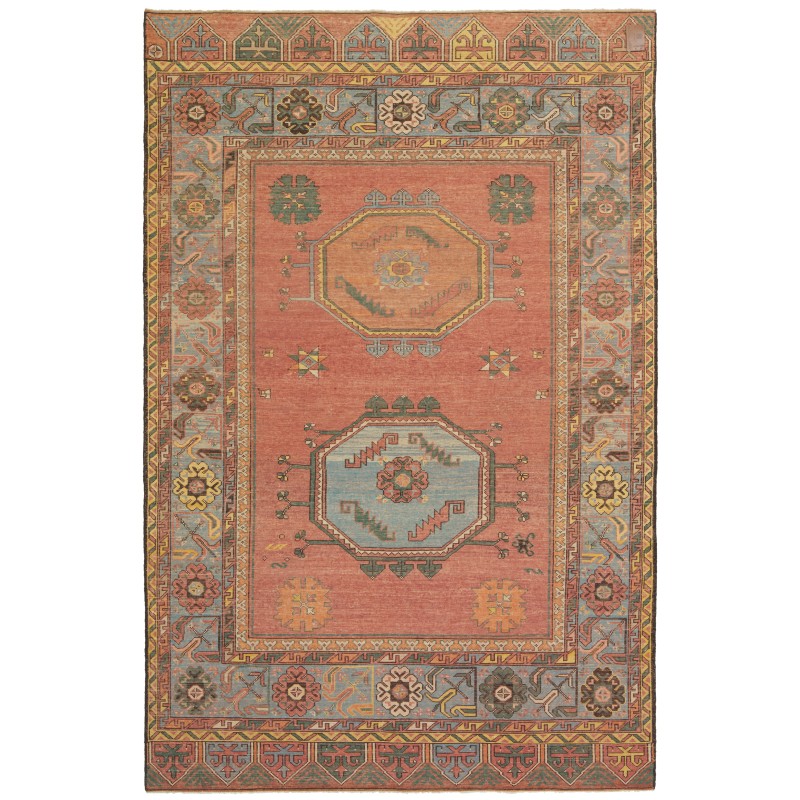



- Stock: In Stock
- Model: C50490
- サイズ: 255cm x 168cm
- Weight: 8.70kg
- SKU: ART490
これはトルコの中央アナトリア地域、コニャ地方の18世紀の絨毯のデザインの主要要素として、双子のメダリオンを持っています。このタイプの絨毯は、2つのメダリオンを使用したものは、ヴェネツィア派とフラマン派の両方の15世紀の絵画に頻繁に登場します。このパターンの伝統は、この絨毯が非常に力強い例であるアナトリア村の絨毯に18世紀や19世紀に至るまで残りました。フィールドをほぼ全て占める2つのオクタゴンは、中央に小さなオクタゴンを囲み、その中から星のように四角形のパネルが放射状に広がっています。これらのパネルには「ラッチフック」のパターンが詰まっています。典型的な双子のメダリオンを持つ中央オクタゴンの絨毯には、16世紀の「ホルバイン」絨毯によく見られる星と結び目のデザインが一般的で、15世紀にも使用されていました。フィールドのバランスは、隅に星とロゼットの渦巻きを持つ分離したオクタゴンの列で構成されており、コンパクトでやや静的なデザインに動きを与えています。ボーダーパターンは、元々花の形に基づいていましたが、完全に幾何学的な単位に分割されています。アナトリアの絨毯やキリムに関する専門家の間では、古代の価値やアイデアの象徴を記録していると信じられており、これは何千年も前の伝統であり、産業時代になるまで取って代わられることはありませんでした。アナトリアのキリムデザインの伝統は、おそらくパイル織りの絨毯がより貴重に見え、何千年も前から高い威信を持っていたことによる幸運な生存をもたらしました。そのため、キリム織りは長い期間、独自の文化的な文脈の中で平穏に生き残ることができました。この絨毯のデザインは解釈され、柔らかな色が選ばれています。
This is a dual medallion as the main element of the design of 18th-century carpet from the Konya region, Central Anatolia area of Turkey. Rugs of this type, using two medallions, appear frequently in 15th-century paintings of both the Venetian and the Flemish schools. This pattern tradition survived into the 18th and even into the 19th century in Anatolian village rugs of which this is an exceptionally powerful example. The two octagons that fill almost all of the field enclose a small octagon in the center from which radiate rectangular panels in a star-like fashion, filled with “latch-hook” patterns. Typical two medallions central octagon carpets contain a star-and-knot design commonly found in “Holbein” rugs of the 16th century and used already in the 15th century. The balance of the field features rows of detached octagons with stars and rosette volutes in the corners which give a sense of movement to the otherwise compact and somewhat static design. The border pattern, although originally based on floral forms, is entirely broken up into geometric units. Among specialists, Anatolian carpets and kilims are believed to record symbols of ancient values and ideas, a tradition that dates back several millennia and was only displaced during the industrial age. The Anatolian kilim design tradition probably owes its lucky survival to the fact that pile-woven carpets look more precious and would already have had a higher prestige value several millennia ago. Kilim weaving was, therefore, able to survive undisturbed within an intact cultural context for a long period of time. The design of this rug is interpreted and soft colors are chosen for this rug.
私たちが作ったオリジナルの絨毯です。昔の作り方、染め方全て守って明日のアンティーク絨毯を眼材しています。 この絨毯作るのに全部で 10 色使っています。
- Red Robin 125 (トウダイグサ - 茜)
- Dusty Turquoise 340 (トウダイグサ - 茜 - 藍 - クルミの殻)
- Dark Brawn 316 (羊そのままの色)
- Russian Green 418 (ヘナ - 藍)
- Salmon 536 (茜)
- Khaki 413 (ホザキモクセイソウ)
- Misty Moss 14 (トウダイグサ - 茜)
- Coral 531 (茜 - クルミの殻)
- Raked Leaves 503 (ヘンナ)
- Deer 528 (茜 )
上の番号は私たちのカラーコードです。()の中は、主な草木染めの材料です。
